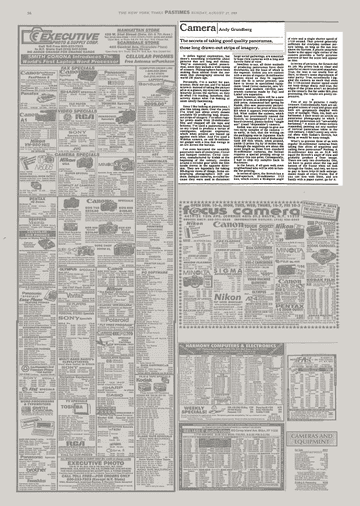
By Andy Grundberg
Aug. 27, 1989
كاميرا بانوراما سيركت Cirkut
About the Archive
This is a digitized version of an article from The Times’s print archive, before the start of online publication in 1996. To preserve these articles as they originally appeared, The Times does not alter, edit or update them.
Occasionally the digitization process introduces transcription errors or other problems; we are continuing to work to improve these archived versions.
It defies logical explanation, but there’s something irresistible about pictures that are long and skinny. They’re commonly called panoramas, since they include a wide sweep of scenery. Photographers have been making them almost from the moment that photography entered the world 150 years ago.
Personally, I’m a sucker for panoramas. Show me one, and I’m bound to love it. Instead of taking the picture all in at a glance, my eyes can wander leisurely across the surface, as they do when I’m reading. Somehow, that activity makes what I’m looking at seem totally fascinating.
Since I like looking at panoramas, I also like taking them. Over the years I’ve tried just about every means available for producing long, drawn-out strips of imagery. I’ve taken regular prints made from 35-millimeter film and chopped off the tops and bottoms. I’ve used a panorama head on my tripod to produce a series of continguous, adjacent exposures, which when printed are butted up against each other. And I’ve used a Widelux camera, an odd 35-millimeter gadget with a lens that swings in an arc across the horizon.
I’ve even borrowed the unwieldy panoramic tools of yesteryear, Circut and banquet cameras. Circut cameras, manufactured by Kodak at the beginning of the century, revolve around a circular gear while the film inside moves in the opposite direction. They are legendary for taking 360-degree views of things. Some enterprising photographers still use them. Banquet cameras, so-called because they were used to document large social gatherings, are essentially huge view cameras with a long and narrow field of view.
Needless to say, all these methods of producing panoramas have their drawbacks, not the least of which is the expense. Unless you are content with a series of regular 35-millimeter frames sliced so they fit together (and the fit is never precise), you have to invest in specialized equipment. Used Circut cameras, new Wideluxes and modern roll-film panoramic cameras made by Fuji and Linhof are expensive.
Soon, however, there will be a new player in town, at a downright reasonable price. Announced last spring by Kodak, this new panoramic picture-taker will have a list price of less than $15 when it appears everywhere this fall. What makes the camera, which Kodak has provisionally named the Stretch, so inexpensive? It’s a cardboard-covered, plastic-bodied ”single use” (read ”disposable”) camera.
Kodak was nice enough to give me two early samples of the camera – so early, in fact, that the writing on the packaging was in Japanese. Each holds a 12-exposure roll of Kodacolor Gold 200 film which, when printed, yields 12 prints 3 1/2 by 10 inches long. Although the negatives are about the same length as those from standard 35-millimeter cameras, the format requires a special printing set-up to produce this size print. Consequently, I had to ship my samples back to Rochester.
In the future, if all goes well, even neighborhood labs will be able to handle the printing.
In terms of specs, the Stretch has a fixed-aperture, 25-millimeter f/12 lens, which covers a 90-degree angle of view and a single shutter speed of 1/110 second. That proved generally sufficient for everyday outdoor picture taking, so long as the sun was above the horizon. A plastic peep-hole finder in the upper right corner of the camera provides a fairly accurate preview of how the scene will appear on film.
In terms of pictures, the Stretch did its job. My prints look as clear and colorful as more truncated snapshots. True, the lens is not totally free of flare, so there’s some degradation of color purity. True, occasionally I jiggled the camera so much that even the 1/110-second shutter speed could not keep things sharp. And true, the edges of the prints aren’t as detailed as the centers. But for under $15, plus processing, the results are pretty impressive. Two of my 24 pictures I really treasure. Coincidentally, both are unpeopled scenes of trees and grass and both are gorgeously dappled with rays of sunlight. Then, too, both are horizontal. I once wrote an article on panoramic photography in which I said that panoramas are ”unvariably horizontal.” A score of letter-writers responded, pointing out any number of vertical panoramas taken in the 19th century. I didn’t assay any vertical shots with Kodak’s Stretch, but doing so would be easy enough.
What’s to prevent those of us with regular 35-millimeter cameras from taking thin slices of negatives and calling them panoramas? Nothing. A 24-millimeter lens on an SLR will equal the Stretch’s angle of view and probably produce a finer image. There are only two drawbacks. One, we have to guess about the top and bottom of the frame when we look through the finder, and two, we have to pay to have 8-by-10 inch enlargements made of every frame. But if you can live with these, and are handy with a paper cutter, go for it.


